|
Mamiya Z-Series 35mm Cameras
The Mamiya Z-Series cameras were the last
35mm SLR's produced by Mamiya. Innovation was still apparent. It
was the first Japanese SLR to use an electronic coupling system
to transmit information between the camera body and its interchangeable
lenses. Previous interactions between lenses and camera bodies had
been by mechanical pins, cams or levers. While many manufacturers
were reluctant to make changes that would render their lenses obsolete,
Mamiya aggressively pursued the new mount configuration. In addition,
ergonomics, as applied to the functionality and use of the camera,
began to play a stronger role in their design.
Join the
Collecting Mamiya 35mm Forum (it's free!) if you have Mamiya Z-series information
to share!
See the
Digital Photography Review of the
Mamiya ZD.
|
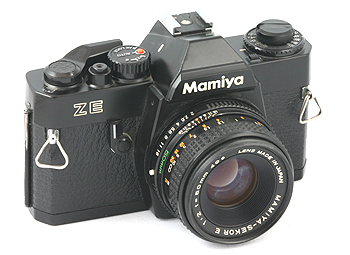
The MAMIYA ZE was sometimes also
designated as the MAMIYA ZE QUARTZ (below), although the cameras
were, in fact, identical.
CLICK HERE
for Mamiya ZE Quartz lens & accessory
information.
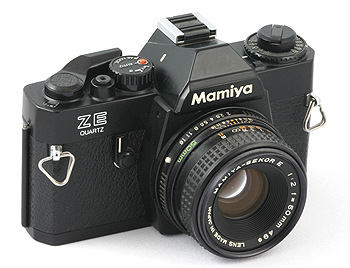

A Rare Silver Mamiya ZE

MAMIYA ZE, rebranded as the Bell & Howell.Z
|
Mamiya ZE
The Mamiya ZE (left; some were also designated
ZE Quartz) was introduced in July 1980. It has a metal, quartz-controlled,
focal-plane shutter and a center-weighted photo diode. An aperture-priority
AE, exposure can be corrected ± two stops, and a previously-metered
exposure can be locked in "AEL" position (same dial as the orange
"Auto" button in the picture).
It requires four (4) MS76 or equivalent
batteries, which are still readily available. The ZE can also be used without
batteries. If you set the shutter mode selector to "X" the shutter operates at 1/90 sec.
Simply use the Sunny 16 Rule to figure the
aperture setting for your weather conditions.
Most ZE's were solid black, but there is a rare version that used a silver top plate (see picture,
below left). A version of the Mamiya ZE, also with a silver top
plate, could be found in the USA, rebranded as the Bell & Howell
.Z (picture, below left).
A lens comparison
from Popular Photography.
 
The three gold electrical contacts in the
Mamiya ZE body (above, left), at a time when there were 10 contacts in the E
and EF lenses made for them (above, right), hinted at the plans Mamiya already
had in the works for transmitting information.
The bayonet-mount lenses (E or EF series) have
gold electronic contacts. It is interesting to note the body of the Mamiya ZE
had only three electrical contacts, while the interchangeable lenses introduced
with the camera had ten. They were already potentially capable of transmitting
information about aperture requirements, shutter speed, and more, to subsequent
generations of cameras beyond the ZE.
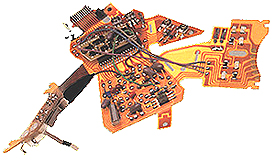
The Mamiya ZE central processor
A sophisticated central processor was incorporated into the ZE
series, an indicator of the changing direction of cameras, from simple
mechanical devices, to small, computerized machinery.
While it is possible Mamiya CS lenses from the NC1000 can be
used on the ZE, you can only do it with a loss of the auto-aperture function
(not recommended). The lenses are also 90° off in the mount. Because of a
different pin-reading element, E or EF lenses from the Z-Series cameras will
not work on the NC.
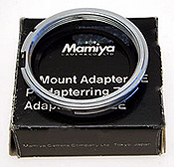 
MAMIYA P-ADAPTER (left) and a
ZE 645 ADAPTER (right)
Like the NC-series before it, Mamiya made an adapter
for the Z-series cameras enabling them to use 42mm threaded lenses
(above, left). While the original intent was, more than likely,
to allow previous Mamiya owners to continue using existing threaded
Mamiya lenses from their DTL and SX camera series of a few years
before, many threaded lenses from other brands also work with this
adapter.
An adapter was also available allowing use of the
outstanding Mamiya C lenses from the mid-size Mamiya 645 (above,
right). Mamiya Z-series cameras seem to be in plentiful supply today,
but both adapters are hard to find, and can sometimes be pricey.

|
Mamiya ZE-2
Introduced in December 1980, the Mamiya ZE-2
(right) continued the quartz-regulated metal focal plane shutter begun in
the ZE. Both cameras have an automatic exposure with aperture priority and,
once it is determined, the aperture setting on both can be locked. The ZE-2
added a shake-prevention warning and a shutter-speed dial, and allowed
a manual override (you can't select a shutter speed manually on the
ZE). An electronic sensor coupled each lens to the camera through six gold
contact points. The sensor automatically selected the slowest hand-held
shutter speed possible for that focal length. The Mamiya ZE-2 was also
rebranded and sold in Germany as the Revue AM.
Like the ZE, the Mamiya ZE-2 requires four (4) MS76 or equivalent batteries.
It also uses the same sharp, contrasty Mamiya-Sekor E or EF optics that were
found in the entire Z-series. However, perhaps because the ZE-2 is seen less
often than its ZE cousin, it frequently brings a slightly higher price in
auction.
CLICK HERE
for Mamiya ZE-2 lens & accessory information.
|
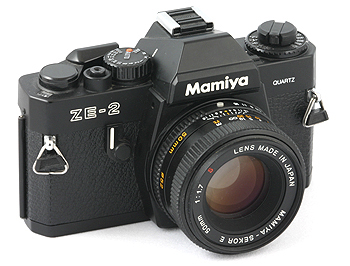
MAMIYA ZE-2 Ron Herron Collection

MAMIYA ZE-2 rebranded as the REVUE AM Quartz
|
|

MAMIYA ZE-X, shown here and below with optional
left-hand shutter release

CLICK HERE
for ZE-X lens & accessory information.
|
Mamiya ZE-X
The Mamiya ZE-X, (left) when introduced in
September 1981, was the world's most advanced cross-over system
camera. A particularly sophisticated automatic exposure control
system meant the camera could be used in either aperture- or shutter-preferred
automatic modes. If the system determined the photographer's selection
of shutter speed or aperture was incorrect, a crossover network
would automatically override the setting. The microprocessor could
shift the entire exposure diagram and change the preset value until
it reached the appropriate automatic range.
Still maintaining the vertical metal focal-plane shutter, it provides aperture- or
shutter-speed priority selection, an automatic flash light-volume control by
distance, and camera-shake prevention. It also has eight (8) AE mode program
selections. You even begin to see the ergonomic thinking that
would eventually sweep the camera industry, in the triangular bulge added to
the front of the ZE-X body, designed to provide a secure grip while advancing
the film lever. The ZE-X requires only two (2) MS76, or equivalent, batteries.
The Mamiya ZE-X was also the only Mamiya Z-series camera to offer an optional
left-hand shutter release (pictured on a camera from my collection, at left).
The left-hand shutter release is an extremely rare accessory today, and very
hard to find.
The Mamiya ZE-X was also rebranded and sold by Quelle in Germany as the
Revue X4-M.
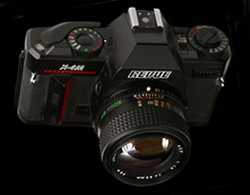
MAMIYA ZE-X rebranded as the REVUE X-4M
|
Mamiya ZM Quartz
Released in October 1982, the Mamiya ZM (right)
was the last Mamiya 35mm camera to be produced. An advanced version
of the ZE-2, with some of the features of the ZE-X, it has an aperture-priority
automatic time control, based on center-weighted TTL readings, and
an automatic shutter-speed range from four (4) seconds to 1/1000
and a manual range from two (2) seconds to 1/1000. Like the ZE-X, it takes
two (2) MS76, or equivalent, 1.5v batteries.
It has both optical and audio signals indicating over- or under-exposure,
pending battery failure, or excessive camera shake. Improvements
were also found in the metering modes, shutter release, self-timer,
manual time settings and the on/off switch. The ergonomics of the
camera body itself were even better, noticeable in the increased
body bulge near the film advance lever, for a more comfortable grip.
While the ZM can use the E and EF series lenses that were used on
previous Z-series bodies, specific ZM lenses actually started into
production, and can frequently be found today in auction. They are
the Mamiya-Sekor E "S" series, identified by a red "S" on the lens
ring, along with the white "E" designation (see photo at right).
Power Failure
However, in 1984, in one of the greatest economic failures in Japanese
history - Osawa, the sole distributor of Mamiya cameras (and a maker
of photographic lenses under its own name) filed a petition in Tokyo
District Court for application of the Corporate Rehabilitation Law
(the US equivalent of bankruptcy). This event severely affected
worldwide distribution channels for Mamiya, and the decision was
made to end manufacture of Mamiya 35mm cameras. Mamiya Corporation
continued to produce top-of-the-line medium format professional
cameras, but its significant 35mm era had come to an end.
 The existence
of a 35-105mm f/3.5-4.3 macro-focusing Mamiya E zoom lens was
only conjecture, until recently. This lens does not show up in any
Mamiya literature I have, and no photos were available. But thanks
to reader Karl Adams, in Australia, the proof now exists! The existence
of a 35-105mm f/3.5-4.3 macro-focusing Mamiya E zoom lens was
only conjecture, until recently. This lens does not show up in any
Mamiya literature I have, and no photos were available. But thanks
to reader Karl Adams, in Australia, the proof now exists!
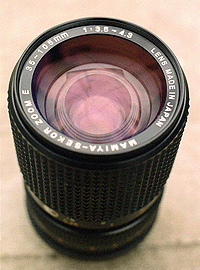
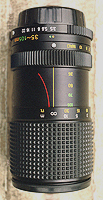
MAMIYA-SEKOR 35-105mm ZOOM E Lens.
Photos courtesy Karl Adams, Australia.
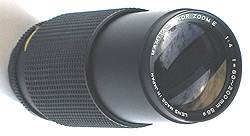
ANOTHER INTERESTING FIND. A MAMIYA 80-200
ZOOM E Lens with an f/4 aperture, instead of the f/3.8 listed in all
the available literature.
Photo courtesy Reijo Lauro, Finland.
|
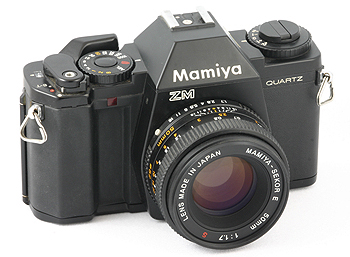
MAMIYA ZM, the last of the Mamiya
35mm produced
CLICK HERE
for Mamiya ZM lens & accessory information.
The Mysterious
Mamiya ZF
Thanks to Gerry Walton, in Worcester, England, for
bringing an article from the December 1982 issue of the "The British
Journal of Photography" to my attention. The article indicates a
prototype Mamiya 35mm camera known as the Mamiya ZF was in
development at the time Mamiya dropped its 35mm camera production.
There are no known photos of this prototype.
It was described as similar in appearance to the ZM, but with a
larger left-hand handgrip to house four AAA batteries needed to
operate a lens autofocus control. There was also a green LED at
the bottom of the finder, to show correct focus. Yet another LED
was designed to indicate insufficient light for a reliable sharpness
measurement.
A Mamiya 50mm f/1.7 autofocus lens proposed for this Mamiya
ZF was 40mm long, 74mm high, and 65mm wide. With a built-in motor
powered by the camera's batteries, this lens would have been among
the most compact of its kind. The required power supply to the many
features of the lens would have run through no less than 15 contacts.
The article indicated that a 135mm f/2.8 autofocus was also being
prepared. The mere existence of the Mamiya ZF prototype and its
compact autofocus lens make it abundantly clear that Mamiya had
great future plans for its 35mm line. Should one of the prototypes
of this camera or its lenses ever surface, it would be a much
sought-after prize!
The existence
of the ZF prototype, when accompanied by the known plans for Mamiya
to collaborate in the marketing of a revived Voigtländer
Bessamatic (to be produced as a variant of the Mamiya ZM, with
a it is interesting to speculate what might have happened if Osawa
had managed to avoid financial disaster in 1984, letting Mamiya
continue the development of its amazing 35mm line.

In 1984, a variant of the MAMIYA ZM
-- to be sold as a Voigtländer Bessamatic -- was in the planning
stage (stylized image above, courtesy Joerg Mueck, Germany). Plans called for
a Mamiya ZM body with a Voigtländer Color-Ultron MC 50mm f1.7 lens.
However, it never made it into production, and fewer than 20 were
ever made!

|
| |
